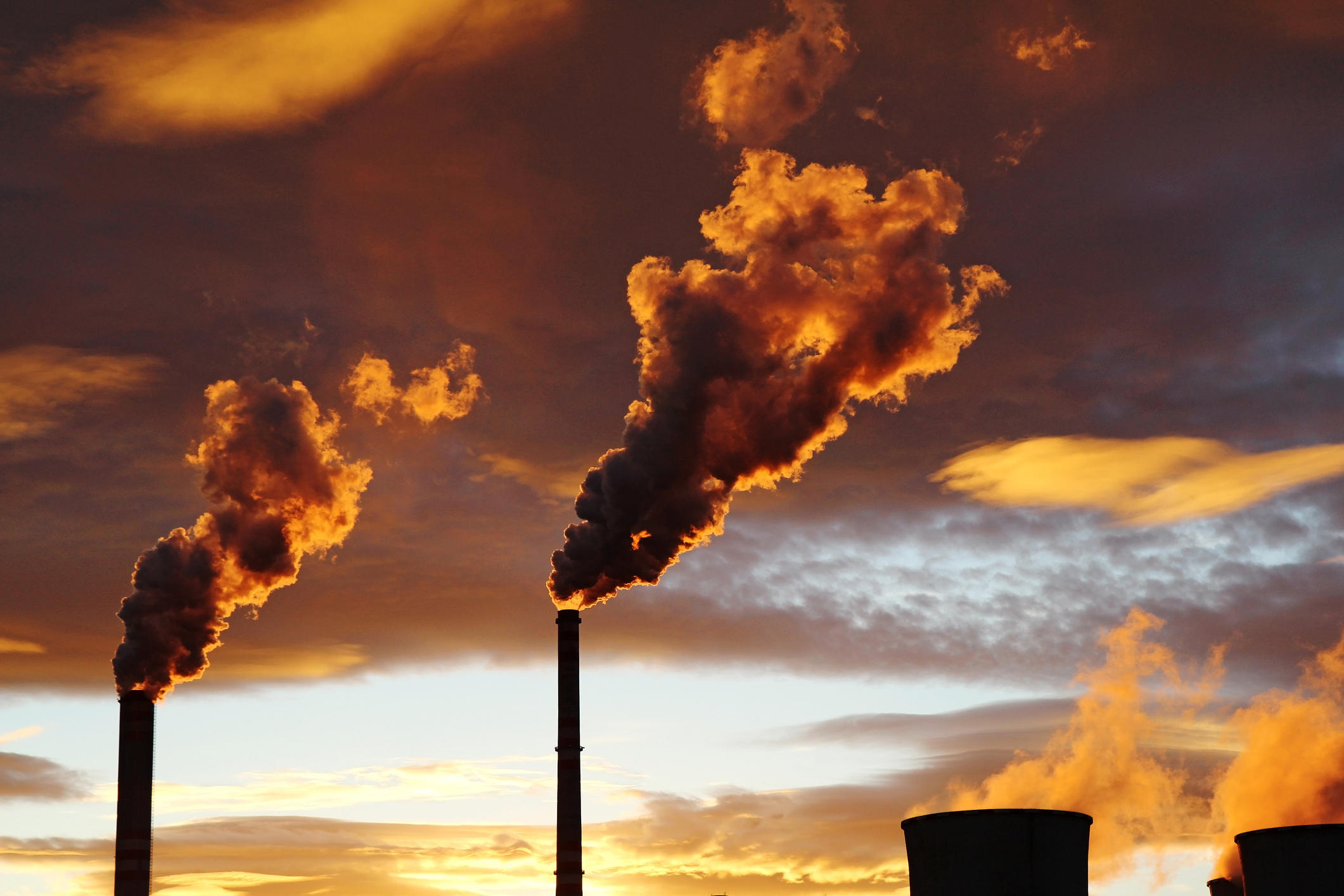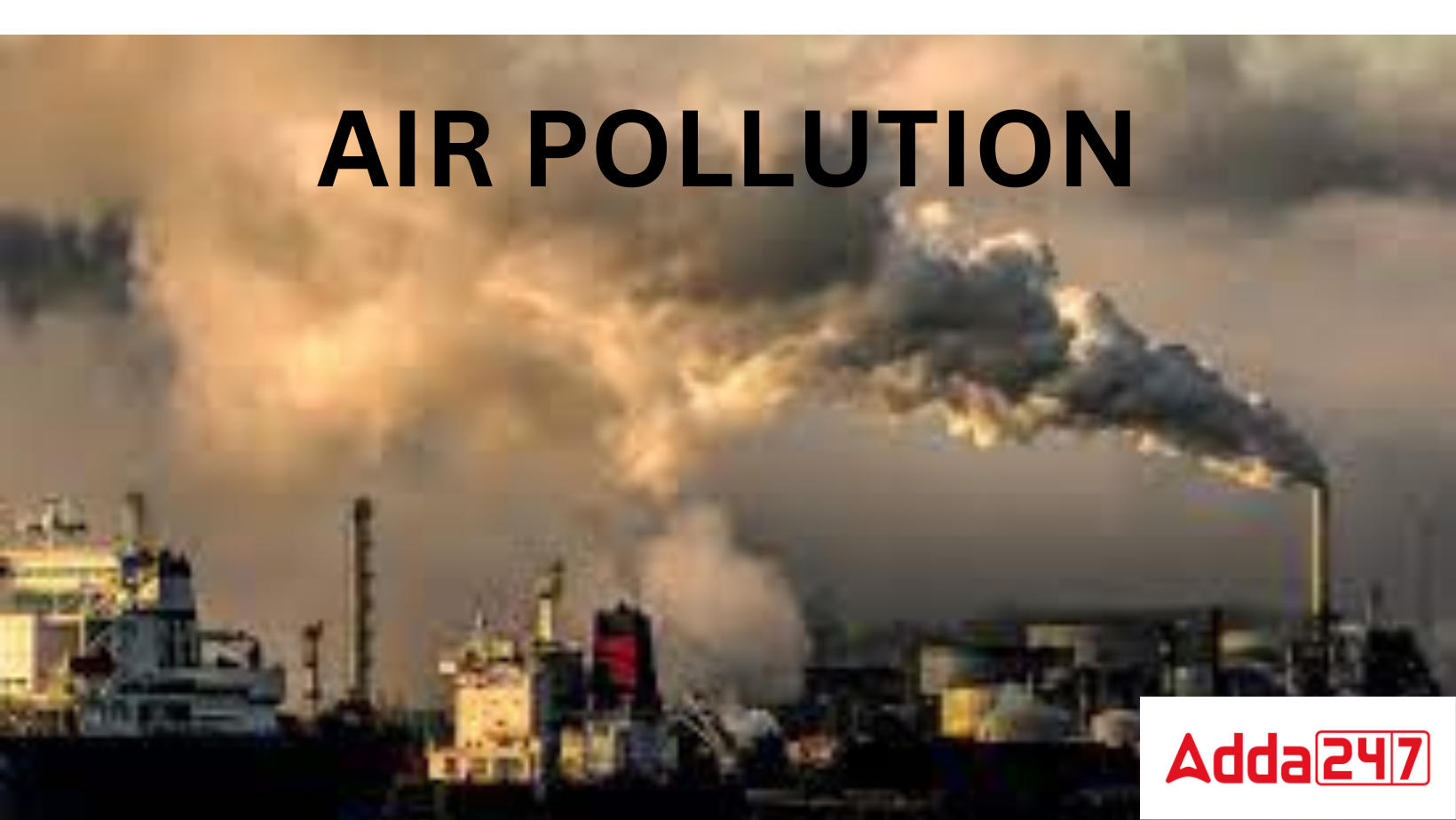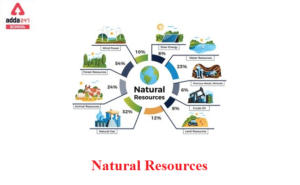Table of Contents
Air Pollution Definition
A combination of gases and solid particles in the air cause air pollution. Particles that may be suspended include factory chemicals, dust, pollen, and mould spores. A significant source of ozone pollution in cities is a gas. Smog is the name for the air pollutions that results from ozone.
Air Pollution Meaning
Any physical, chemical, or biological alteration in the air is referred to as air pollutions. The major impact of air pollution on plants, animals, and people is caused by noxious gases, dust, and smoke.
The atmosphere contains a specific proportion of gases. It is detrimental to survival if the content of these gases increases or decreases. Global warming is the term used to describe the increase in the earth’s temperature caused by this imbalance in the gaseous composition.
Air Pollution Pictures for School Project Assignment
Air pollution pictures and Images for the school project are given below.


Air Pollution Information
Air pollution information refers to the presence of harmful or undesirable substances in the Earth’s atmosphere, which can have adverse effects on the environment, human health, and the well-being of other living organisms. These pollutants can be in the form of gases, particulate matter (tiny solid or liquid particles suspended in the air), or other compounds that, when present in high concentrations, can degrade air quality.
Air Pollution Information regarding Common air pollutants:
Particulate Matter (PM): Tiny particles or droplets in the air that can be inhaled into the lungs. PM can be of various sizes, with PM2.5 (particles with a diameter of 2.5 micrometers or smaller) and PM10 (particles with a diameter of 10 micrometers or smaller) being particularly concerning for human health.
Ground-Level Ozone (O3): Formed when pollutants from vehicles, industrial facilities, and other sources react in the presence of sunlight. Ground-level ozone can irritate the respiratory system and cause other health problems.
Nitrogen Oxides (NOx): Gases produced by combustion processes, mainly from vehicles and industrial sources. They contribute to the formation of smog and can have adverse effects on respiratory health.
Sulfur Dioxide (SO2): A gas produced by burning fossil fuels containing sulfur, primarily in industrial processes and power plants. It can irritate the respiratory system and contribute to acid rain.
Volatile Organic Compounds (VOCs): Organic chemicals that can easily evaporate into the air, coming from sources like gasoline, industrial processes, and some household products. VOCs can contribute to the formation of ground-level ozone and smog.
Carbon Monoxide (CO): A colorless, odorless gas produced by incomplete combustion of carbon-containing fuels. It can be harmful when inhaled in high concentrations, interfering with oxygen delivery to the body’s cells.
Heavy Metals: Elements such as lead, mercury, and cadmium can become airborne through industrial processes and have toxic effects on both the environment and human health.
Air pollution can result from various human activities, including transportation, industrial processes, energy production, agriculture, and even natural sources like wildfires and volcanic eruptions. It poses significant health risks, including respiratory and cardiovascular diseases, and can also harm ecosystems, damage buildings and infrastructure, and contribute to climate change when it involves greenhouse gases like carbon dioxide (CO2) and methane (CH4). Efforts to reduce and control air pollution are crucial for protecting both human health and the environment.
Also read: Environmental Pollution Essay in English 1000 words
Air Pollution Causes
Following are the causes of Air Pollution
Causes 1: Burning of Fossil Fuels
Fossil fuel combustion releases a lot of sulphur dioxide into the atmosphere. Air pollution is also caused by carbon monoxide, which is generated when fossil fuels are burned inefficiently.
Causes 2: Automobiles
Vehicle emissions, including those from trucks, cars, buses, and jeeps, harm the environment. These are the main producers of greenhouse gases, and they also make people sick.
Causes 3: Agricultural Activities
One of the most dangerous gases released during agricultural operations is ammonia. Insecticides, pesticides, and fertilizers contaminate the atmosphere by emitting dangerous chemicals.
Causes 4: Factories and Industries
The primary source of carbon monoxide, organic compounds, hydrocarbons, and chemicals is industry and manufacturing. These are dispersed into the atmosphere, lowering the quality of it.
Causes 5: Mining Activities
The dust and chemicals released during the process of mining not only pollute the air but also affect the health of workers and people living in nearby places.
Causes 6: Domestic Sources
Some household products and cleaning chemicals contain toxic chemicals that are released in the air during their usage those. The smell and chemicals of that toxic product present in the air not only pollutes the air but increase breathing problem also.
Air Pollution Effects
Some common effects of air pollution are discussed below
Diseases
Humans have developed a number of respiratory conditions and heart ailments as a result of air pollution. Over the past few decades, there has been an upsurge in lung cancer cases. Children who live close to polluted environments are more likely to get asthma and pneumonia. Each year, many individuals pass away as a result of air pollution, either directly or indirectly.
Global Warming
There is an imbalance in the gaseous composition of the air as a result of the release of greenhouse gases. The earth’s temperature has risen as a result of this. Global warming is the term used to describe this rise in earth’s temperature. As a result, glaciers are melting and the sea level is rising. There are many places that are underwater.
Must read: Global Warming- Definition, Causes and Effects
Acid Rain
When fossil fuels are burned, dangerous chemicals like sulphur oxides and nitrogen oxides are released into the atmosphere. When water droplets interact with these contaminants, they turn acidic and release rain that harms both people and animals as well as plants.
Ozone Layer Depletion
The main factor contributing to the ozone layer’s depletion is the emission of hydrochlorofluorocarbons, halons, and chlorofluorocarbons into the atmosphere. People develop skin ailments and eye issues as a result of the sun’s harmful ultraviolet rays, which the ozone layer’s loss cannot stop.
Effects on Animals
Aquatic life is impacted by the air contaminants that suspend in water bodies. Additionally, pollution forces animals to relocate from their natural environment. This makes them stray and has caused a great deal of animal species to go extinct.
Air Pollution Project
Creating a project on air pollution is a great way to raise awareness about this important environmental issue and explore potential solutions. Here’s a step-by-step guide to help you plan and execute your air pollution project:
Step 1: Define the Purpose and Scope
- Start by clearly defining the purpose of your project. What do you hope to achieve with it? Are you aiming to raise awareness, propose solutions, or both?
- Determine the scope of your project. Will you focus on a specific aspect of air pollution, such as its sources, health effects, or solutions?
Step 2: Research and Gather Information
- Research the causes and effects of air pollution. Use credible sources such as government agencies, scientific journals, and environmental organizations.
- Collect data on air quality in your area, if possible. You can use air quality monitoring stations or portable air quality sensors.
Step 3: Create a Project Plan
- Develop a project plan that outlines your goals, timeline, and resources needed.
- Decide on the format of your project. Will it be a presentation, a report, a website, a video, or a combination of these?
Step 4: Raise Awareness
- Design eye-catching visuals and materials to raise awareness about air pollution. This could include posters, infographics, or social media posts.
- Organize events or activities to engage your community, such as workshops, webinars, or clean-up campaigns.
Step 5: Propose Solutions
- Research and present solutions to mitigate air pollution. This may include government policies, technological innovations, lifestyle changes, and community initiatives.
- Highlight the importance of individual actions in reducing air pollution, such as using public transportation, reducing energy consumption, and supporting clean energy sources.
Step 6: Communicate Findings
- Create a compelling presentation or report summarizing your research, findings, and proposed solutions.
- If relevant, share your project with local government officials, community leaders, or environmental organizations to garner support for your ideas.
Step 7: Take Action
- Encourage your audience to take action. Provide practical tips and resources for individuals and communities to reduce air pollution.
- Consider collaborating with local organizations or activists working on air quality improvement projects.
Step 8: Evaluate and Reflect
- Assess the impact of your project. Did it raise awareness? Did it inspire people to take action?
- Reflect on the challenges you encountered and what you learned during the project.
Step 9: Share Your Project
- Share your project with a wider audience through social media, local news outlets, and online platforms to reach as many people as possible.
Step 10: Stay Involved
- Continue to stay involved in environmental advocacy and stay informed about air quality issues.
- Consider participating in ongoing initiatives or starting new projects to address air pollution.
Remember to document your project thoroughly, both for your own learning and to share your experience with others. Engaging with your community and raising awareness about air pollution can have a positive impact on the environment and public health.
Air Pollution: Ways to Stop
Here, we are discussing some ways to control air pollution
- Avoid using vehicles for nearby places.
- Since industrial emissions are one of the main contributors to air pollution, the pollutants can be reduced at the source by controlling or treating them. For instance, if a certain raw material reacts in a way that produces a pollutant, the raw material can be replaced with one that produces less pollution.
- Use CNG in the place of diesel or petrol.
- Maintain and modify pollution control equipment from time to time so that these can work properly.
- The last but important way to reduce air pollution is to plant more and more trees in your surroundings.
Air Pollution Causes
There are two types of air pollutants
- Primary Pollutants
- Secondary Pollutants
Primary Pollutants
The pollutants that directly cause air pollution are known as Primary Pollutants. Sulfur dioxide emitted from factories directly is an example of a Primary Pollutant.
Secondary Pollutants
Secondary pollutants are those that are created when primary pollutants mix and react with one another. Smog is a secondary pollutant that is created when smoke and fog mix.
Air Pollution Assignment
the whole process of working on an air pollution project assignment. Here’s a step-by-step outline of what you can do:
- Choose a Specific Topic:
- Decide on a specific aspect of air pollution that you want to focus on. For example, you could explore the causes, effects, solutions, or a specific pollutant like PM2.5 or CO2 emissions.
- Research and Gather Data:
- Collect data and information related to your chosen topic. Use reliable sources such as scientific journals, government reports, and environmental organizations’ websites.
- Formulate Research Questions:
- Based on your research, create a set of research questions that you aim to answer in your project. These questions should be clear and specific.
- Create Multiple-Choice Questions:
- Now, let’s create multiple-choice questions related to your research. Please specify the topic or aspect you’ve chosen, and I can generate relevant questions for you. For example, if you’re focusing on the effects of air pollution, I can create questions like:
- Question 1: What is a common health effect of long-term exposure to air pollution? a) Headaches b) Respiratory problems c) Skin rashes d) Obesity Correct Answer: b) Respiratory problems
- Now, let’s create multiple-choice questions related to your research. Please specify the topic or aspect you’ve chosen, and I can generate relevant questions for you. For example, if you’re focusing on the effects of air pollution, I can create questions like:
- Analyze and Interpret Data:
- Use the data you’ve gathered to support the answers to your research questions. Include charts, graphs, and statistics to illustrate your findings.
- Write Detailed Solutions:
- For each multiple-choice question you’ve created, provide detailed explanations or solutions. Explain why the correct answer is correct and why the other options are incorrect. This helps in enhancing understanding.
- Compile Your Assignment:
- Organize your project assignment in a clear and logical manner. Include an introduction, methodology, results, discussion, and conclusion sections. Make sure to cite your sources properly.
- Proofread and Edit:
- Carefully proofread your assignment to eliminate errors in grammar, spelling, and formatting.
- Submit Your Assignment:
- Follow the submission guidelines provided by your instructor or institution.
- Presentation (If Required):
- If your assignment includes a presentation, create slides that summarize your project’s key points and findings.


 50 Trees Name in English and Hindi
50 Trees Name in English and Hindi
 Types of Natural Resources with Examples
Types of Natural Resources with Examples
 All 100 Birds Name in Hindi and English
All 100 Birds Name in Hindi and English














